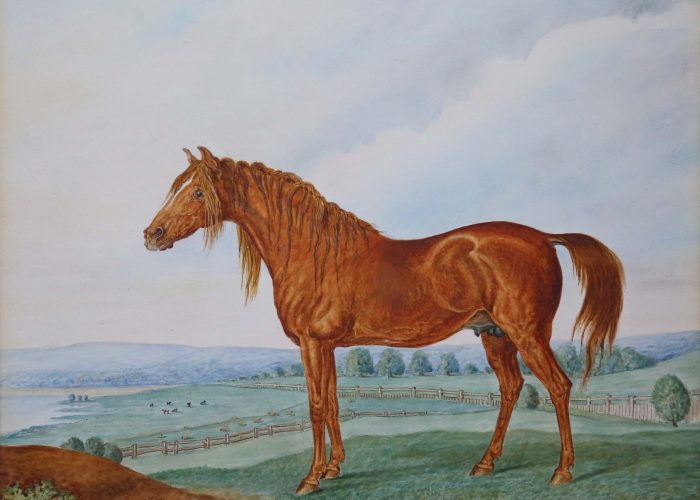A painting of Copenhagen, Wellington’s war horse at Waterloo
A painting of Copenhagen, Wellington’s war horse, which the Great Duke famously rode at Waterloo.
Lord Grosvenor, later Field Marshal Earl Grosvenor, had taken with him on the Copenhagen campaign of 1807 a favourite thoroughbred mare named Lady Catherine, a daughter of the 1793 Epsom Derby winner John Bull.
However, he sent the mare back to England when he discovered that she was in foal to Eclipse’s son Meteor, also bred by Lord Grosvenor. The resulting foal was duly named “Copenhagen” after the victorious siege. The colt turned into a good looking 15.1 hh stallion.
Lord Grosvenor had high hopes of the colt on the turf but fortunately for Wellington his racing career was not distinguished and although he ran in ten races as a three year old there was little success. His name was expunged from the General Stud Book when it was discovered his granddam was not a thoroughbred.
Grosvenor then sold the stallion to Wellington’s Adjutant General in the Peninsula, General Sir Charles Stewart (brother-in-law to Lord Castlereagh). When Stewart was invalided home in 1812 he sold the five year old charger as he had now become to Wellington for 400 guineas.
Copenhagen acquired a fine reputation as the Great Duke’s charger and was remarkably calm under fire as well as being a great stayer. Wellington rode him during the Peninsular Campaign, particularly at Vitoria and in the Pyrenees but he had some fifteen other horses from which to choose. Waterloo actually made the horse’s reputation. Wellington rode him throughout the campaign and there were three particular incidents which could have changed history.
At Quatre Bras the Duke was observing the enemy from a forward position. Behind was a stiff fence and ditch lined by a battalion of 92nd Highlanders. Suddenly some French dragoons appeared and the Duke found himself on the wrong side of the fence. Shouting to the Highlanders to lie down he put Copenhagen to the fence in good hunting style and he cleared fence, ditch and highlanders.
Two days later at Waterloo, late in the afternoon, the case shot which took off Lord Uxbridge’s leg had passed over Copenhagen’s neck before doing its damage.
The third incident was at about 11pm outside the little inn in Waterloo village when the victor of the battle dismounted and gave Copenhagen an approving pat on his hind quarters whereupon the famous horse lashed out and nearly brought the day to a very different end. He was known to be “a bit free with his heals”.
In old age the famous horse was a family favourite and from time to time enjoyed his hunting as indeed his master did too. At one stage the Duke would allow Lady Shelley to ride him.
It is of note that the famous statue by Wyatt of Wellington mounted as he was at Waterloo shows a very different horse from Copenhagen, an animal named Rosemary, and Wyatt was much criticized for that. But there hadn’t been much option – as Copenhagen had died on 12 February 1836, ten years before, aged 28.
The Duke ordered his burial in Stratfield Saye with full military honours. The Times printed an Obituary:
DEATH OF FAMOUS WATERLOO HERO
On 12th February died at Stratfield Saye, of old age, Copenhagen the horse which carried the Duke of Wellington so nobly on the field of Waterloo ……….he lost an eye some years before his death, and has not been used by the noble owner for any purpose during the last ten years. By the orders of his Grace a salute was fired over his grave, and thus was buried as he had lived with full military honours. This horse has long been an attraction to strangers who were accustomed to feed him over the rails with bread, and the Duke himself preserved a special regard for him, which cannot be wondered at, upon considering that he bore him for 16 hours safe through the grandest battle that has occurred in the history of the world. The late amiable Duchess was likewise particularly attached to him, and wore a bracelet made from his hair.
Much later the Royal United Services Institute wanted to exhume Copenhagen’s bones so they could be displayed as Napoleon’s horse Marengo had been. The Great Duke was curt in his refusal. However allegedly when buried it was noted that a hoof was missing and it was not until the Great Duke died that a repentant servant confessed to the mild tempered 2nd Duke.
The 2nd Duke placed a plaque beside the grave with the following inscription:
Here Lies
COPENHAGEN
The charger ridden by
The Duke of Wellington
The entire Day at the
Battle of Waterloo
Born 1808 died 1836
God’s humbler instrument, though meaner clay,
Should share the glory of that glorious day
The 4th Duke planted an acorn beside the grave in 1914 as part of the campaign to save the battlefield of Waterloo from development and unscrupulous exploitation.
The Great Duke said on his death: “There may have been faster horses, no doubt some handsomer, but for bottom and endurance I never saw his fellow”.
Copenhagen although included in several portraits of Wellington was painted on his own by James Ward in 1824. It hangs at Alnwick Castle. The picture illustrated is a copy by FW Barry, displayed at Wellington College, a fitting place.
Sources:
Elizabeth Longford’s Two Volumes on Wellington
The Horse in War by Brereton
-
Use this image
You can download and use the high resolution image for use in a non-profit environment such as a school or college, but please take note of the license type and rights holder information below
- Rights Holder: Wellington College
- License Type: All Rights Reserved





